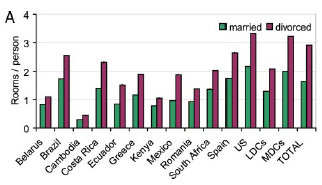Marriage is “greener” than divorce, finds study
Marriage is “greener” than divorce, finds study
mongabay.com
December 3, 2007
Divorce hurts families and the environment
Divorce has previously unrecognized environmental impacts including higher demand for resources and lower efficiency in household resource use, reports a new study published in the early edition of the journal Proceedings of the National Academy of Sciences.
Analyzing data on domestic relations and resource use for the United States and 11 other developed and undeveloped countries, Michigan State University researchers Eunice Yu and Jianguo Liu found unsurprisingly that divorce results in smaller average household size. However, the smaller average size of divorced households had led to a larger number of total households and greater demand for energy, water, and land.
“Divorced households in the U.S. could have saved more than 38 million rooms, 73 billion kilowatt-hours of electricity, and 627 billion gallons of water in 2005 alone if their resource-use efficiency had been comparable to married households,” write the authors. “U.S. households that experienced divorce used 42-61% more resources per person than before their dissolution.”
 Average numbers of rooms per person in divorced households and married households. |
In total, for the 12 countries assessed, Yu and Lui found that the number of rooms per person in divorced households was 33—95% greater than in married households.
“The results from this study… indicate that divorce escalates consumption of increasingly limited resources (water, land, and energy) through household proliferation and reduction in household size. Because of higher consumption per person, an individual in a divorced household may also generate more waste (solid, liquid, and gaseous material like greenhouse gases) that contributes to global environmental changes such as climate
change and biodiversity loss,” the authors write. “Although waste is not analyzed in this study, other studies show that waste per person increases with a decrease in household size.”
The researchers note that other social trends–including declines in multigenerational households, delays in first marriages increases in empty-nesters, and increases in separated couples–can led to a decline in household size and extra households. However Yu and Lui say that that remarriage by the head of the household eliminates the extra demand on resources.
 Marriage is greener than divorce. |
In the interest of environmental sustainability, Yu and Lui recommend that people and governments take note of the environmental impacts of divorce and other lifestyles such as separation.
Mitigating the impacts of resource inefficient lifestyles such as divorce helps to achieve global environmental sustainability and saves money for households,” Yu and Lui conclude.
Globally, divorce rates have been climbing steadily since the 1970s. In the United States, the proportion of divorced households jumped from five percent in 1970 to 15 percent in 2000; while in Brazil, Colombia, Costa Rica, Greece, and Venezuela the rate more than doubled. Even in China, where divorce in not traditionally common, divorce is on the rise.
The results, which tie marriage to environmental benefits, may provide fuel for “green evangelicals”, religious leaders who are increasingly supportive of greater environmental stewardship.
Related
Environmentalism is born with exposure to nature before age 11
A new study out of Cornell University suggests that environmentalism is born in children who are exposed to nature before the age of 11. Nancy Wells, assistant professor of design and environmental analysis in the College of Human Ecology at Cornell, and Kristi Lekies, a research associate in human development at Cornell, analyzed data from a 1998 U.S. Department of Agriculture Forest Service survey that examined childhood nature experiences and adult environmentalism. The researchers sampled more than 2,000 adult Americans, ages 18 to 90, about their early childhood nature experiences and their current adult attitudes and behaviors relating to the environment.
World’s largest movement has no leader but 100M employees
The world’s largest movement has no name, no leader, and no ideology, but may directly involve more than 100 million people, said a green business pioneer.